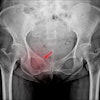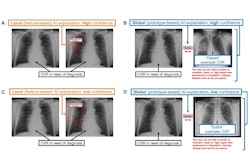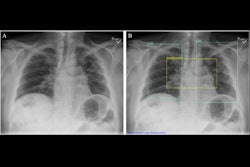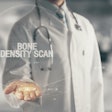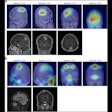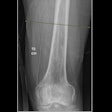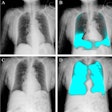AI-assisted triage of lung x-rays using commercially available software could help reduce turnaround times in real-world settings by 77%, according to an article published October 10 in the European Journal of Radiology.
A group led by Srinath Sridharan, PhD, of Changi General Hospital in Singapore, also found that the software (CXR Triage, Lunit) achieved a specificity of 99% in urgent cases and thus could aid in critical decisions.
“This validation is crucial to overcome the limitations of previous retrospective studies and to address concerns about the applicability of AI across varied patient demographics and clinical scenarios,” the researchers wrote.
CXR Triage received clearance from the U.S. Food and Drug Administration (FDA) in 2021, yet evidence is lacking on its usefulness in mainstream clinical settings, the authors explained. The software is designed to triage chest x-rays as normal, nonurgent, or urgent, and has previously demonstrated high accuracy in detecting pneumothorax and pleural effusion, for instance.
In this study, the researchers integrated the software into their hospital’s PACS. Between August 2023 and December 2023, 43 radiologists approved 20,944 chest x-ray reports that the AI had triaged into normal, non-urgent, and urgent. The images were acquired in the hospital’s emergency department.
Out of the 20,944 chest x-rays, 28.6% were normal, 61.2% were nonurgent, and 10.2% were urgent. According to the analysis, the AI system demonstrated a sensitivity of 89% in correctly identifying normal CXRs, with a specificity of 93%.
“This suggests that the software is highly reliable in detecting cases without abnormalities, indicating a reduced likelihood of false positives in normal [chest x-ray] classifications,” the authors wrote.
For nonurgent chest x-rays, the software exhibited a sensitivity of 93% and a specificity of 91%, indicating robust performance in identifying chest x-rays that do not require immediate attention, they suggested.
In the urgent category, the software achieved a sensitivity of 82% and a specificity of 99%, demonstrating its potential utility in clinical settings for flagging conditions that need immediate intervention.
In addition, in an analysis of turnaround times, AI outperformed radiologists in minimum turnaround time (0.02 min vs. 0.17 min), with a median of 8.5 minutes compared with 432.1 minutes for radiologists, according to the team.
“The effectiveness of the [CXR Triage] in accurately triaging chest x-rays across a diverse patient cohort has been validated,” it noted.
Ultimately, the study was designed to simulate an emergency department environment whereby the information generated by the AI triage system would be used by the ED physician or a clinician in the ward to make a judgment on the immediate management or disposition of the patient.
However, additional research is needed before deploying the system, the investigators urged.
“Future investigations should delve into the long-term impacts of AI integration on healthcare outcomes, aiming to ensure that the benefits of AI in radiology are widely realized,” they concluded.
The full study is available here.



